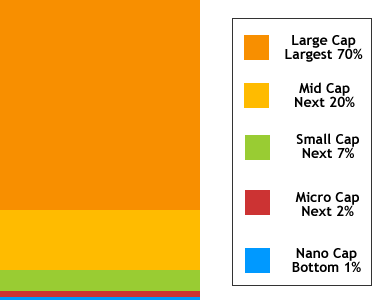What do all these asset classes in the model portfolio comparisons mean, anyways? Total Market? Large-Cap? Value? One big hurdle is that there are no set definitions for any of these classes, and each individual mutual fund can and will use it’s own interpretation. But let’s try anyways, starting with equities.
Market capitalization
Often simply referred to as “cap”, this is the company’s value as determined by multiplying the number of outstanding shares of stock by the current market price for one share.
Total US Stock Market
While the definition seems self-explanatory, there a bunch of different benchmarks used to track the entire domestic stock market on a cap-weighted basis. These all try to represent the roughly 5,000 companies currently being publicly-traded on major domestic stock exchanges.
Total International Stock Market
This theoretically includes all publicly-traded companies headquartered outside the US. As of 2005 this was over 20,000 companies, and tracking all of them is no easy feat.
The international stock market is further broken down into Developed and Emerging markets based on per-capita GDP and the maturity of the country’s stock markets. Examples of developed markets include Canada, Australia, Germany, Japan, and the United Kingdom. Examples of emerging markets include Russia, China, South Africa, and Turkey.
Further dividing both domestic and international markets are size and style considerations.
Size Classifications – Large Cap / Mid Cap / Small Cap / Micro Cap
These are tough to define, as they change over time and people rarely agree completely anyways. Here’s how they look graphically as percentages of the market cap in their geographic area:1

By total value, here’s roughly how they break down:2
Large Cap – Market cap of $10 billion and above.
Mid Cap – Market cap between between $2 billion and $10 billion.
Small Cap – Market cap between between $300 million and $2 billion.
Micro Cap – Market cap between $50 million and $300 million.
Nano Cap – Market cap under $50 million.
Style Classifications – Value / Core / Growth
In general, value stocks are deemed to be under-priced somehow by the market. Growth stocks are companies whose earnings are expected to grow at an above average rate relative to the market.
Everybody seems to disagree on how define value or growth using numerical values like price, book value, historical earnings, future earnings, growth rates, or sales. Morningstar divides all companies equally between Value, Core, and Growth based on a formula that includes the following components and weights:
Value Components
50.0% Price/Prospective Earnings ratio
12.5% Price/Book ratio
12.5% Price/Sales ratio
12.5% Price/Cash Flow ratio
12.5% Dividend yield
Growth Components
50.0% Long-term projected earnings growth
12.5% Historical earnings growth
12.5% Sales growth
12.5% Cash flow growth
12.5% Book value growth
REITs
Real Estate Investment Trusts are one of the easier and liquid ways to invest in real estate. While there are equity, mortgage, and hybrid REITs, usually equity REITs are what are tracked by REIT index funds. Although technically most REITs are already included in other index funds since they are traded as stocks, as a separate class they have been found to have a low correlation to both stocks and bonds.
1Based on Morningstar definitions and All About Asset Allocation by Ferri.
2According to Investopedia and other online sources.
 The Best Credit Card Bonus Offers – March 2024
The Best Credit Card Bonus Offers – March 2024 Big List of Free Stocks from Brokerage Apps
Big List of Free Stocks from Brokerage Apps Best Interest Rates on Cash - March 2024
Best Interest Rates on Cash - March 2024 Free Credit Scores x 3 + Free Credit Monitoring
Free Credit Scores x 3 + Free Credit Monitoring Best No Fee 0% APR Balance Transfer Offers
Best No Fee 0% APR Balance Transfer Offers Little-Known Cellular Data Plans That Can Save Big Money
Little-Known Cellular Data Plans That Can Save Big Money How To Haggle Your Cable or Direct TV Bill
How To Haggle Your Cable or Direct TV Bill Big List of Free Consumer Data Reports (Credit, Rent, Work)
Big List of Free Consumer Data Reports (Credit, Rent, Work)
Because you are young I would go with 20% small cap, by this I mean the RUSSEL2000. The RUSSEL 2000 always out preforms the indexes.